******UNDER EMBARGO UNTIL 11:00 AM ET MARCH 16, 2021******
Why is this topic important to explore?
Overproduction of the protein Rab1A promotes carcinogenesis through turning on an enzyme called mTOR, a major growth driver in colorectal and liver cancers. Rab1A knockout mice are deficient of normal glucose control and develop diabetes. Rab1A knockout impairs insulin production from pancreatic beta-cells. In contrast, Rab1A knockout increases glucagon production by converting beta-cells to alpha-cells. Insulin and glucagon are hormones produced in the pancreas responsible for lowering and raising blood sugar level, respectively. Our body’s production of insulin and glucagon is commonly known to respond to changing blood glucose levels. This work is important to explore because according to the Centers for Disease Control and Prevention (CDC), 30 million or 12 percent of American adults suffer type two diabetes, with another 84 million American adults being pre-diabetic. Without proper intervention, pre-diabetes will progress to type 2 diabetes in five years.
Tell us what the team discovered.
Insulin and glucagon are commonly known to respond to blood glucose level (from carbohydrate diets). This study shows that amino acids (from protein diets), through Rab1A-mTOR nutrient signaling pathway, also control these endocrine hormones. We also found that Rab1A expression is lost in the beta-cells from both type 1 and type 2 diabetes patients, suggesting that Rab1A loss contributes to development of these metabolic diseases. Insulin and glucagon producing cells switch to each other in response to amino acid levels. This cell type conversion helps to control the level of these hormones.
What are the implications of these findings?
This study shows that amino acids signaling controls whole-body glucose homeostasis through regulating endocrine hormone production. It reveals an interesting interplay between two major nutrients, amino acids and glucose. Deficiency of proper amino acids signaling is risk factor for developing diabetes. Targeting this pathway could lead to more effective dietary intervention and therapeutic treatment for diabetes, and possibly pancreatic cancers. For example, protein diets would be helpful for diabetic patients to control their blood sugars. On the other hand, because this pathway is uniquely important for beta-cells, its overactivation may cause a class of cancer called pancreatic neuroendocrine tumors that are derived from beta-cells.
Along with Dr. Zheng, the authors include Xin Zhang, Xiaowen Wang, and Ziqiang Yuan, Rutgers Cancer Institute and Rutgers Robert Wood Johnson Medical School; Sarah J. Radford, Rutgers Cancer Institute of New Jersey; Chen Liu, Yale University; and Steven K. Libutti, Rutgers Cancer Institute of New Jersey and Rutgers Robert Wood Johnson Medical School.
This work was supported by grants from the National Institute of Diabetes and Digestive and Kidney Diseases (R01 DK124897) and Rutgers Cancer Institute of New Jersey Advanced Microscopy, Biomedical Informatics, Biospecimen Repository, Flow Cytometry/Cell Sorting and Genome Editing Shared Resources (P30 CA072720). Additional information can be found here *LINK TO PAPER



